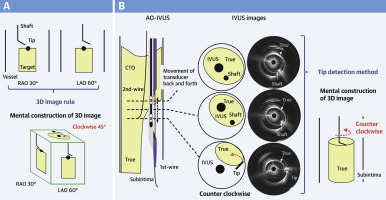当前位置:
X-MOL 学术
›
JACC Cardiovasc. Inte.
›
论文详情
Our official English website, www.x-mol.net, welcomes your
feedback! (Note: you will need to create a separate account there.)
Tip Detection Method Using the New IVUS Facilitates the 3-Dimensional Wiring Technique for CTO Intervention.
JACC: Cardiovascular Interventions ( IF 11.7 ) Pub Date : 2019-12-05 , DOI: 10.1016/j.jcin.2019.07.041 Atsunori Okamura 1 , Katsuomi Iwakura 1 , Mutsumi Iwamoto 1 , Hiroyuki Nagai 1 , Akinori Sumiyoshi 1 , Kota Tanaka 1 , Takamasa Tanaka 2 , Koichi Inoue 1 , Yasushi Koyama 1 , Kenshi Fujii 1
JACC: Cardiovascular Interventions ( IF 11.7 ) Pub Date : 2019-12-05 , DOI: 10.1016/j.jcin.2019.07.041 Atsunori Okamura 1 , Katsuomi Iwakura 1 , Mutsumi Iwamoto 1 , Hiroyuki Nagai 1 , Akinori Sumiyoshi 1 , Kota Tanaka 1 , Takamasa Tanaka 2 , Koichi Inoue 1 , Yasushi Koyama 1 , Kenshi Fujii 1
Affiliation

|
OBJECTIVES
This study assessed the efficacy of the tip detection method during intravascular ultrasound (IVUS)-based 3-dimensional (3D) wiring with a new chronic total occlusion (CTO)-specific IVUS system (AnteOwl IVUS [AO-IVUS]) for CTO percutaneous coronary intervention (PCI).
BACKGROUND
The study developed angiography-based 3D wiring for CTO-PCI. Previously, the authors produced a short-tip CTO-specific IVUS system (Navifocus WR IVUS [Navi-IVUS]), which has been upgraded into the AO-IVUS system by adding a pullback transducer system for IVUS-based 3D wiring.
METHODS
A CTO lesion 20 mm in length composed of 2.5% agar was experimentally inserted into the coronary artery of a beating heart model. The target (a microcatheter with a 0.6-mm lumen) was placed in the distal part of the CTO lesion. IVUS-guided wiring was performed to insert the guidewire into the target using the Navi-IVUS and then using the AO-IVUS 8 times each. In wiring with AO-IVUS, the IVUS-based 3D wiring using the tip detection method was performed. The crossing time and the number of punctures to the target were calculated.
RESULTS
The crossing time was significantly shortened and the number of punctures was significantly reduced in AO-IVUS-based wiring compared with Navi-IVUS-based wiring (median crossing time 80.5 s [interquartile range: 44.0 to 112.3 s] vs. 333.0 s [interquartile range: 88.8 to 790.0 s]; p = 0.036; median 1.0 puncture [interquartile range: 1.0 to 2.0 punctures] vs. 24.0 punctures [interquartile range: 5.8 to 52.5 punctures]; p = 0.001).
CONCLUSIONS
The tip detection method enables the authors to easily perform the IVUS-based 3D wiring, and the new CTO IVUS system will facilitate this method in clinical practice.
中文翻译:

使用新 IVUS 的尖端检测方法促进了 CTO 干预的 3 维布线技术。
目标 本研究评估了尖端检测方法在基于血管内超声 (IVUS) 的 3D (3D) 布线中使用新的慢性完全闭塞 (CTO) 特异性 IVUS 系统 (AnteOwl IVUS [AO-IVUS]) 对 CTO 的功效经皮冠状动脉介入治疗 (PCI)。背景 该研究为 CTO-PCI 开发了基于血管造影的 3D 布线。此前,作者制作了一个短尖的 CTO 专用 IVUS 系统(Navifocus WR IVUS [Navi-IVUS]),该系统通过增加用于基于 IVUS 的 3D 布线的回拉换能器系统升级为 AO-IVUS 系统。方法在心脏跳动模型的冠状动脉中,实验性地将一个由2.5%琼脂组成的20mm长的CTO病变插入。目标(具有 0.6 毫米管腔的微导管)放置在 CTO 病变的远端部分。使用 Navi-IVUS 和 AO-IVUS 分别使用 IVUS 引导线将导丝插入目标中。在使用 AO-IVUS 进行布线时,进行了使用尖端检测方法的基于 IVUS 的 3D 布线。计算穿过目标的时间和穿刺次数。结果 与基于 Navi-IVUS 的布线相比,基于 AO-IVUS 的布线的交叉时间显着缩短,穿刺次数显着减少(中位交叉时间 80.5 s [四分位距:44.0 至 112.3 s] vs. 333.0 s [四分位距:88.8 至 790.0 s];p = 0.036;中位数 1.0 次穿刺[四分位距:1.0 至 2.0 次穿刺] vs. 24.0 次穿刺[四分位距:5.8 至 52.5 次穿刺];p =)。结论 尖端检测方法使作者能够轻松执行基于 IVUS 的 3D 布线,
更新日期:2019-12-11
中文翻译:

使用新 IVUS 的尖端检测方法促进了 CTO 干预的 3 维布线技术。
目标 本研究评估了尖端检测方法在基于血管内超声 (IVUS) 的 3D (3D) 布线中使用新的慢性完全闭塞 (CTO) 特异性 IVUS 系统 (AnteOwl IVUS [AO-IVUS]) 对 CTO 的功效经皮冠状动脉介入治疗 (PCI)。背景 该研究为 CTO-PCI 开发了基于血管造影的 3D 布线。此前,作者制作了一个短尖的 CTO 专用 IVUS 系统(Navifocus WR IVUS [Navi-IVUS]),该系统通过增加用于基于 IVUS 的 3D 布线的回拉换能器系统升级为 AO-IVUS 系统。方法在心脏跳动模型的冠状动脉中,实验性地将一个由2.5%琼脂组成的20mm长的CTO病变插入。目标(具有 0.6 毫米管腔的微导管)放置在 CTO 病变的远端部分。使用 Navi-IVUS 和 AO-IVUS 分别使用 IVUS 引导线将导丝插入目标中。在使用 AO-IVUS 进行布线时,进行了使用尖端检测方法的基于 IVUS 的 3D 布线。计算穿过目标的时间和穿刺次数。结果 与基于 Navi-IVUS 的布线相比,基于 AO-IVUS 的布线的交叉时间显着缩短,穿刺次数显着减少(中位交叉时间 80.5 s [四分位距:44.0 至 112.3 s] vs. 333.0 s [四分位距:88.8 至 790.0 s];p = 0.036;中位数 1.0 次穿刺[四分位距:1.0 至 2.0 次穿刺] vs. 24.0 次穿刺[四分位距:5.8 至 52.5 次穿刺];p =)。结论 尖端检测方法使作者能够轻松执行基于 IVUS 的 3D 布线,











































 京公网安备 11010802027423号
京公网安备 11010802027423号